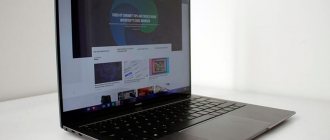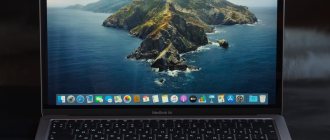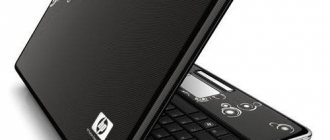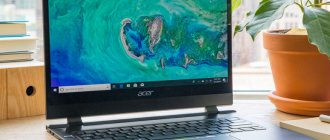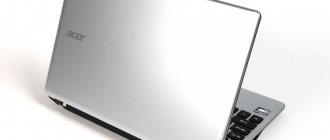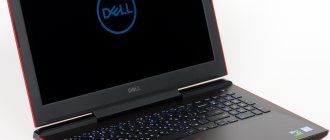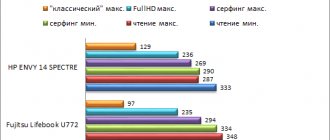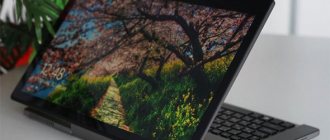Unboxing Xiaomi Mi Notebook Pro
The laptop came to me from the Gearbest online store. The site traditionally offers the best prices on the Internet for laptops from Xiaomi, and the Pro version is no exception.
The parcel arrived by EMS in about 3+ weeks. The computer was packed in a nesting doll of three boxes: the first two were technical, the third was made of thick, white cardboard with luxurious printing.
The box from Xiaomi Mi Notebook Pro was opened before me, but there is no need to worry about this. Gearbest employees always do this in order to check the device for defects. If everything is ok, then the device flies to the buyer. The practice may be controversial, but personally I would prefer that my equipment be checked in advance, rather than here in Russia I will encounter some unpleasant surprise and start corresponding with technical support about how to send the whole thing back, then wait, then wait some more and so on.
Under the laptop there is a neat envelope with “quick instructions”, and at the level below there is a power supply with a Chinese plug and a cable (1.5 meters) with a two-way USB C connection.
If anything, the beech is charged only from the top port. If you mistakenly connect the wire to the lower USB C, the system will prompt you to plug the plug into the correct input. The correctness of the action is indicated by an LED nearby.
Xiaomi Mi Notebook Pro: Unboxing
Like any major equipment from Xiaomi, devices come in regular cardboard paper, and the new generation of laptops is no exception.
On one side you can see the name of the model, and on the side there is a sticker with technical features.
Inside the box, I found a separate box containing a power adapter and a Type-C charging cable. I would like to note right away that the presence of Type-C is a good start, since RedmiBook 13 does not have this connection at all.
The laptop itself is protected on all sides by polystyrene foam, and therefore the device came to me intact and without any damage.
Design
All poppy-headed users, when they get a “wee”, conduct a test on a MacBook. I am one of them, so I did it literally right away. And yes, you can exhale. The test is passed - the laptop lid can be opened with one finger without any problems. The laptop itself stands motionless.
My perfectionist is satisfied, so I can start studying the appearance of the device.
The first thing that needs to be said about the Mi Notebook Pro is that it looks simply amazing!
I am not kidding! After using Xiaomi Mi Notebook Pro for at least a day, you will never agree to switch to some Acer or, God forbid, HP.
Yes, for example, Dell has the XPS series for normal, business guys in ties. Lenovo has a Yoga line for fashionistas (although what would a fashionista be without a MacBook?). But none of the computer hardware manufacturers have a laptop designed for normal people with an adequate sense of style. Amendment! Now it is. Thanks Xiaomi.
Still, it’s not for nothing that our hero is compared to Apple’s MacBook Pro. There is almost the same attention to design, details, ergonomics and body materials.
MacBook Pro 13
Do you know what the most pleasant thing is after you turn the laptop back and forth and look into all the cracks? This is the realization that you did not give money for it, comparable only to the down payment on a mortgage in Moscow. Later I will definitely tell you how you can buy a Xiaomi Mi Notebook Pro at the best price. Well, for now let's move on.
And yes, the affordable price tag relates specifically to the design. Firstly, we begin to get to know a laptop precisely from its appearance. Only then do we turn it on, configure it and enjoy the performance. Secondly, knowing that you saved a lot of money, but got a top-end device, sets the design on fire and makes you perceive the laptop in a new way. Believe me, I know what I'm talking about. For me, the cost of any gadget is the most important characteristic. Only then come gigahertz, number of ports and other things.
Convenience
In the design chapter I got a little off topic. It's time to catch up.
Let's start with the dimensions of the device.
Despite the fact that our laptop is thin and all around so elegant, it is still a 15.6-inch machine, the dimensions and weight of which make themselves felt.
I threw the same Mi Notebook Air 12.5 into my backpack and immediately forgot about its existence - the weight of the beech (1.07 kg) was practically not felt even after a few hours.
This trick won’t work with the Mi Notebook Pro, because it weighs almost 2 kg. I threw it into my backpack (by the way, I have just such a copy) and the bag became seriously heavier. When the backpack hangs behind your shoulders on two straps, there is no discomfort. However, we take with us not only a computer, but also a notebook, a charger, or maybe two, a smartphone, a wallet, a camera and something else - all this together weighs quite a lot.
What I mean is that those who need a lightweight, portable typewriter with a powerful filling that will be used from time to time, get ready - you will either have to endure the weight of the beech or abandon this model. Still, both the 12.5- and 13-inch options also have something to offer in terms of performance.
Top cover
The laptop opens up to 150 degrees. It is quite enough for any situations, especially since there is no touch screen here.
The lid does not play, it holds very tightly, there are no crunches, squeaks or other criminal problems. If you pick up the laptop and shake it slightly, the screen will open up a little. You can shake it more sharply, but you feel sorry for the device. After all, the machine costs 55 kilo rubles.
From the outside there is nothing at all. No logos, inscriptions or other fluff.
I think it’s very cool on Xiaomi’s part to take the lid like this and leave it without a corporate logo.
Still, every manufacturer tries to define itself, but there is nothing here. This reminds me of the situation when some drivers remove emblems from their cars, and as a result, you cannot understand at all what kind of BMW is in front of you. In terms of headlights it seems to be a three, and in terms of bodywork a five. Do you know what I mean? Or am I the only one who can’t distinguish the third from the fifth series without a special nameplate?
Keyboard
The buttons are large, the clicks are clear and very soft. There is no knocking like on a typewriter.
However, I was very wary about the location of the function keys in the rightmost column. In theory, when you type blindly, it is important that Enter is located at the very edge, so that you tap it without looking and often sloppily and there are no mistakes. And in the case of Xiaomi Mi Notebook Pro, we have a “PgUp” button here and, it would seem, misses past “inter” will fall on this key. But no! Nothing like that happens.
But the right shift could be longer. You pass him occasionally, but you still miss him.
The most important thing is that the power button, thanks to a column with function keys, is separated from the letter area of the keyboard. As a result, in a fit of inspiration you won’t accidentally press “OFF”, as I did with the Jumper EZbook 3.
The keyboard is backlit. There are exactly two operating modes: either on or off. You won't have much fun.
During testing, I did find one nuance. When typing on a laptop on your lap or even at a desk, your wrists rest on the empty areas next to the touchpad. But my forearms rest against the sharp edges of the laptop.
Thus, the excessively sharp corners of the body begin to “cut” your hands—not the most pleasant feeling.
On the other hand, if you are a man, then be patient! There must be some challenge in the life of a computer scientist.
Touchpad
The best touch panels in the world are installed in MacBooks. Once you get the hang of it, it’s difficult to use anything else. However, Xiaomi Mi Notebook Pro also has a high-quality touch panel. It’s a pity that Force Touch doesn’t support it, and there’s no vibration feedback.
The touchpad is a single button. All standard gestures are supported, including right-clicking, scrolling, two-finger zooming, three-finger viewing of all open windows (swipe up), and so on. Recognition is sensitive and unmistakable. What else is needed?
Fingerprint's scanner
What a cool thing this is!
I don’t have a sensor on my other laptop, so I have to type in my Microsoft account password every time I log in. Laziness! And here you just need to put your finger and voila - you are in the system. There are no errors or inaccurate recognitions at all.
Bottom
No, I’m not talking about the Windows 10 operating system. I’m talking about the bottom surface of the beech.
At first I wondered where the proud inscriptions ala “Powered by NVIDIA”, the branded window sticker and other rubbish were hidden. After all, on the inner surface there was only one modest label, which for knowledgeable people means very, very much...
It turned out that all the information is located below, at the bottom, where it belongs.
Among other things, there are rubber feet that reliably keep the beech from sliding. They don’t stick out much - everything is more or less aerodynamic.
Display
The side frames are quite narrow by the standards of most laptops - 8.5 mm (from the very edges), but I’m sure they could have been made narrower.
Above and below there is a much wider forehead and chin: 13 and 33 mm, respectively. The latter is generally unreasonably large, because apart from the “mi” icon, this place is not occupied by anything.
In fact, I’m finding fault (you have to find fault with something). The frames are normal and don’t bother me at all.
The surface of the screen is covered with protective glass Gorilla Glass 3. The glass is glossy. It is not known for certain, but it is felt that there is an anti-reflective coating. Working in a bright room and opposite a window, of course, is not very comfortable, but it is possible.
The resolution of the 15.6-inch IPS panel is 1920 x 1080 with a pixel density of 142 dpi. This, of course, is not the ultimate dream, but for most situations Full HD resolution is sufficient. The pixel ladder is visible to the naked eye, so, on the one hand, you want more - 2K, for example. On the other hand, the higher the resolution, the more pixels the hardware needs to process. And with Full HD, the processor + video card will show higher performance results.
The viewing angles are excellent - after all, an IPS matrix is used. In terms of color reproduction, everything is fine, but it seemed to me that the picture was a little cold. My iMac 27 delivers a warmer picture and I personally prefer this option. However, without comparing the screens head-to-head, it is difficult to doubt the color rendition.
Russification of Xiaomi Mi Notebook Pro 15.6
Now that we've sorted out the beech's appearance, it's time to study the software. And here we are faced with the first and main challenge - the Chinese version of Windows 10.
Although the system is licensed, it is for one language, so there is only one way out - a complete reinstallation.
I'll tell you about my personal experience.
The first thing you need to do is link your laptop to your Microsoft account.
This way, the licensed Windows and laptop will be linked to a specific account, and after reinstalling Windows and activating your account, the license will transfer to the new system.
My laptop was already activated, all the steps were completed, and since the forum advises entering your data when setting up the computer for the first time, I decided to reset the computer to factory settings.
After the reset, the laptop spoke enthusiastically in Chinese. Moreover, it was so abundant that I had to turn off the sound. I don’t know what I pressed during the initial setup (exclusively all the inscriptions are in Chinese), but in the end everything went like clockwork. Among numerous questions and lengthy downloads, there were only two clear steps: connecting to a Wi-Fi network and entering Microsoft account data. This is the most important thing for our task.
Next, you needed an 8 GB flash drive, pre-formatted with the standard Windows tool in FAT32, and two applications: Media Creation Tool (download from the official Microsoft website) and Rufus (the Internet is full of links).
Open the Media Creation Tool, select “Create installation media for another computer”, in the next window uncheck the box and set the following parameters: “Russian”, “Windows 10”, “64-bit (x64)”. At the third stage, click on the “ISO file” and after that the program will start downloading the system from its servers to the .ISO file.
In the Rufus application, select our flash drive, the “GPT for computers with UEFI” partition scheme, the FAT32 file system, the ISO image downloaded in the previous step, and check the boxes as in the screenshot.
Attention! The application is crooked, so after checking the boxes, the primary parameters disappear - they need to be returned to the configured state. Click “Start” and wait until the bootable flash drive is mounted.
We insert it into our Chinese computer and act almost blindly - there are hieroglyphs everywhere. Open Start, then Control Panel (gear icon). Here we select the icon with two arrows moving in a circle (in Russian this is “Update and Security”), then go to “Recovery” (circular arrow with a clock), then click on the gray block “Restart now” (second from the top).
In the window that opens, click on the picture of the disk with the USB flash drive, select the flash drive prepared in advance by its name.
The remaining points are more or less clear. The only caveat: during the installation, you need to click on the “I don’t have an activation key” option and, without regret, format the partition with pre-installed Chinese Windows (it is usually the third, largest).
Once the installation is complete, during the initial system setup, you need to connect to the Wi-Fi network and enter your Microsoft account information. The license will be picked up automatically.
Xiaomi Mi Notebook Air 13.3″ 2020
- Screen: 13.3 inches, FHD, matte
- Processor: Intel Core i5/i7
- Video card: Intel UHD Graphics 620/GeForce MX250
- RAM: 8 GB
- ROM: SSD, 256 GB
- Weight: 1.3 kg
- OS : Windows 10 Home
Price: from 56,300 rub.
The Air series are thin devices in a metal case with small displays of 12.5 or 13.3 inches. The 13.3-inch model is available in two processor options – Core i5 8250U or Core i7 8550U. Other parameters for the 13.3-inch version are the same. In fact, they both give their owner the opportunity to play, work with graphics, or just surf the net. The battery is designed for 8 hours of operation. Weight 1.3 kg and thickness 14.8 mm make the device convenient to carry.
Despite the thin body, the laptop received effective cooling with two fans, however, unlike previous models, they are not spaced around the edges, but are concentrated in one place. Blowing occurs through one ventilation grille. The case has 2 USB 3.0, Type-C, HDMI and a combined audio jack. Nice features are the presence of a finger scanner and a backlit keyboard. The Harman team was responsible for the sound of Mi Air, which speaks volumes about its quality.
Technical specifications of Xiaomi Mi Notebook Pro
- IPS display 15.6 inches, 1920 x 1080 pixels (142 dpi), aspect ratio 16:9, brightness 300 nits, contrast ratio 800:1, NTSC 72%, Gorilla Glass 3 protection
- processor to choose from: Intel Core i5-8250U (8th generation Kaby Lake R, 4 cores with a base frequency of 1.6 GHz or 3.4 GHz in Turbo Boost mode, 3-level cache 6 MB SmartCache, 14 nm) or Core i7-8550U (8th generation Kaby Lake R, 4 cores with a frequency of 1.8 GHz and 4 GHz in Turbo Boost mode, Level 3 cache 8 MB SmartCache, 14 nm)
- Intel UHD Graphics 620 (300 MHz - 1.15 GHz)
- discrete graphics card NVIDIA GeForce MX150 with 2 GB GDDR5
- RAM 8 or 16 GB DDR4 with a frequency of 2400 MHz
- two slots for SSD: the first is occupied by a 256 GB disk (PCIe connection up to 3 Gb/s), the second is free (M.2 SATA connection)
- connectors: 2x USB C (both are suitable for data transfer at speeds up to 5 Gbps, only the first is also suitable for charging and displaying images on monitors, the second supports fast charging of external devices), 2x USB 3.0 (5 Gbps s, fast charging), HDMI, 3.5 mm audio output, SD card reader (SDHC, SDXC)
- interfaces: Wi-Fi (802.11 ac, 2.4 and 5 GHz), Bluetooth 4.1
- audio: Realtek ALC298 sound card, two speakers from Infinity (HARMAN) with a power of 2.5 W x 2, Dolby Atmos support (in headphones)
- 1 megapixel camera
- 4-cell battery 60 Wh (7900 mAh) with fast charging support
- Windows 10 Home OS (Chinese license) + Microsoft Office key for one computer
- Dimensions: 360.7 x 243.6 x 15.9 mm
- weight 1.95 kg
Xiaomi Mi Notebook Pro: Specifications
| Xiaomi Mi Notebook Pro: | Characteristics |
| Display: | 15.6" IPS 100% sRGB screen with 1920 x 1080 pixel resolution |
| CPU: | Quad-core Intel Core i7-10510U processor up to 4.9 GHz |
| GPU: | NVIDIA GeForce MX250 |
| RAM: | 16 GB |
| Inner memory: | 1 TB SSD |
| Memory Expansion: | up to 2 TB |
| Connection: | Wi-Fi 802.11 a/b/g/n/ac, dual-band and Bluetooth 5.0 |
| Battery: | 7900 mAh |
| OS: | Microsoft Windows 10 |
| Connections: | mini HDMI, USB 3.1, USB 3.1 and 3.5 mm audio jack, Type-C, SD slot |
| Weight: | 1970 |
| Dimensions: | 360.7 x 243.6 x 16.9 mm |
| Price: | $ 1089 |
Performance
After installing all the necessary drivers (you can download drivers for Xiaomi Mi Notebook Pro 15.6 here), I tested the speed of turning on the computer. Here are my results:
- 9 seconds before logging into your account
- 12 seconds and we are on the desktop (thanks to the fingerprint scanner)
It is worth noting that such indicators are typical for a clean computer.
SSD disk speed
After setting up all the necessary applications, I took another measurement. Loading is just as fast, so there are no problems.
I will only note that the laptop needs about 15 more seconds to open all applications that were launched before the reboot or are hanging in autorun. As long as they open, you can use the computer without any problems, it does not freeze or slow down, and documents open a little longer than after the system is fully loaded.
The speed of waking up from sleep mode is the fastest - 3 seconds before logging into your account, and another two seconds are spent unlocking the system using your fingerprint.
I tested gaming performance using Counter-Strike: Global Offensive as an example. I entered the game, set the graphics settings to the maximum possible and got a stable 60 FPS.
Next, I installed GTA V and it didn’t disappoint either. More precisely, the laptop did not disappoint, as at high graphics settings (not maximum) it produced from 24 to 32 FPS. You can play in this situation - I tested it myself.
Finally, some synthetic tests.
Xiaomi Mi Notebook Pro: Design
The appearance of the new generation laptop has remained virtually untouched - it is a typical gray laptop with a minimalist design. There is not a single mark on the front part, and the entire body is made of aluminum alloy.
The design of the laptop is very strong and assembled to a high level. And the first test I do is opening the screen with one hand. Without any doubt, the device has sufficient weight and opens without turning over. This is a good start!
The weight of the Xiaomi Mi Notebook Pro is 1.97 kg, its thickness at the thinnest part is 16 mm, and at the thickest part it is 21 mm. Considering these figures, I can definitely say that the laptop can be transported to school or work without difficulty, although the 15.6-inch screen size is not the most compact.
The frames around the screen, especially on the sides and top, are very small, but at the bottom the frame is twice as large.
Also on the bottom frame you can see the Xiaomi logo, and this is the only element on the device’s body that indicates that this is the Xiaomi brand.
On the top frame, in the middle, there is a front camera for video calls and conferences. It's a 1-megapixel module, but the video quality is quite good and the microphone's audio quality is also up to par.
As for the screen quality? I have no complaints at all, and I want to say that the color rendition and brightness of the screen are at a high level. The colors are very realistic and the detail is high, if you look at the sRGB results, the value is 99%. A very good result, and if you remember the RedmiBook 13 laptop with 65% sRGB, the difference in screen quality is very noticeable.
The keyboard has black keys and they go well with the gray color of the laptop. The keys have good pressure and I didn't have any problems typing. Also, the manufacturer has installed a three-level keyboard backlight, so working in complete darkness is quite possible.
Below the keyboard there is a large touchpad with a good and sensitive panel for operation. Another bonus is the presence of a fingerprint scanner in the upper right corner of the touchpad.
The interface is rich, for example, on the left side there is HDMI 1.4, two USB 3.1 ports and a 3.5 mm audio jack for headphones. On the right side there is an LED indicator for battery charge status, one Type-C port for charging and another Type-C port for data transfer and an SD card slot.
The lower part of the case received holes for the cooling system, five rubber anti-slip feet, two speakers from Harman with very volume and good bass.
There are also additional holes between the keyboard and the screen for heat dissipation, and under high loads the upper part of the keyboard gets a little hot. I did not notice any other shortcomings when testing the new generation laptop.
Sound
The laptop received two speakers from Infinity (the Harman brand, which in turn belongs to Samsung). Perhaps some of the readers will remember the Infinity One wireless speaker, which I tested 2.5 years ago. Those acoustics surprised me with a very decent sound. The Notebook Pro's speakers didn't disappoint either.
The sound quality is good, there is no wheezing, and the maximum volume is enough for the whole crowd to watch a movie from a laptop, even in a large room.
The only thing the speakers lack is bass. They are almost completely absent. And only in this parameter the sound of our hero is inferior to MacBooks.
Problems
Overall, the laptop has no problems. There are nuances. Critical for some, not so much for others.
The first inconvenience is the lack of Russian symbols. However, you can always engrave it. Given the excellent price-performance ratio of the laptop, this is definitely not a problem.
Xiaomi Mi Notebook Pro cannot be called a silent computer. When the coolers are working, and they turn on periodically, and even because there is nothing else to do, there is a decent amount of noise around. Not a vacuum cleaner, of course, but it could have been quieter.
On specialized forums, users say that by updating to BIOS version 502, the problem of sudden coolers turning on goes away. It’s scary to imagine how they worked on previous versions, because the latest update was installed on my laptop.
The second is heating. When playing Counter-Strike: GO, the surface of the laptop heated up to 48 degrees in the area of the letter “Y”. Closer to “Q” and Backspace, the temperature was normal - around 35 degrees.
I'm not sure that long and periodic heating during games will be beneficial for the laptop.
After all, the hardware here is very compact, everything fits together as closely as possible, so after a couple of years of intensive use, the legs of some element on the motherboard may become unsoldered. Or maybe it will pass. In any case, if you plan to periodically play complex 3D shooters, then it won’t hurt to take care of additional cooling - buy, for example, a stand with external fans.
One more nuance. The drivers for the video card, which can be downloaded from the official Xiaomi website, did not work for me. The problematic version is 382.64. But revision number 390.65, downloaded manually from the official NVIDIA website, went as expected.
Xiaomi Mi Notebook Pro: Battery
Under the hood of the 2020 generation Xiaomi Mi Notebook Pro laptop there is a battery with a capacity of 7900 mAh or 60.04 Wh.
Of course, battery life will depend on the load and screen brightness, but in my case, I got about 5.5 hours of battery life with 70% screen brightness and active use. For example, I conducted various benchmark tests, played heavy games, watched YouTube videos and much more. Of course, the result of battery life may be more or less than mine.
Charging time from 1 to 100% took approximately 2 hours and for such a large battery capacity this is a strong and fast result.
Autonomy
The built-in 60 Wh battery provides (according to official data) the following autonomy indicators:
- 6 hours of online video playback in HD resolution at 2/3 brightness and 75% volume
- 9 hours of Full HD video playback from memory (brightness 2/3, volume 75%)
- 8.5 hours of Internet surfing using Microsoft Edge
The results are impressive and I can only confirm them myself. For example, on one charge I managed to deploy Windows from scratch (installation and initial configuration), install all the drivers, download additional ones, and also work for about 3 hours. After all this, about a third of the battery capacity remained.
Fast charging is provided by the included power supply. My measurements look like this:
- 30 minutes of charging gives 48% battery capacity
- 1 hour - 87%
- 1 hour 30 minutes - 99%
Moreover, the last percent takes a very long time to be born. The battery reaches 100% only after only 2 hours of recharging in total.
Where and for how much to buy?
The laptop is currently sold exclusively in China. The official prices of Xiaomi Mi Notebook Pro are as follows:
- Core i5 + 8 GB of RAM – 49,700 rubles or 5,599 Chinese yuan ($883)
- Core i7 + 8 GB – 55,000 rubles or 6,199 yuan ($977)
- Core i7 + 16 GB – 62,100 rubles or 6,999 yuan ($1,104)
Do you think it’s impossible to buy a laptop for this money? You are catastrophically mistaken, because buy a Xiaomi Mi Notebook Pro even cheaper!
I don’t know how, but the Gearbest online store gives very tasty prices. Moreover, the basic modification (core i5 + 8 GB) now costs $968.99, and this is not much more expensive than the official Chinese price tag. The intermediate one will cost $1098.99.
But older models are unreasonably expensive and you need to buy them from Gearbest exclusively using coupons. From time to time, I will update the latest codes directly in this review so that you always have the opportunity to buy Xiaomi Mi Notebook Pro at the best price.
For example, now the top modification costs about $1128.99. The overpayment is quite insignificant.
I recommend Gearbest for a reason. Firstly, because my laptop came from there. There were no problems with the device or delivery.
Secondly, this is a benefit. You can consider my referral an advertisement, or you can consider it useful advice. In any case, when you dig into the market for the best price, you will still have to return to the original option that I advised. Especially considering the unique discount coupons that Gearbest periodically provides.
Of course, when buying a laptop, it makes sense to use the Letyshops cashback service. For example, from the purchase of a standard configuration you can return 3.6% of the cost or $31 (1,750 rubles). In my opinion, a great way to get the most out of your purchase.
And by the way, if you found my review of Xiaomi Mi Notebook Pro useful or like our project as a whole, then supporting it is very simple - just register in the Letyshops service using this link. You will also receive your cashback if you had registered through any other blogger, and I will understand that people are interested in what I do, and most importantly, they get real benefits from it.
Xiaomi Mi Notebook Pro 15.6″ GTX Edition - a solution for professionals
This laptop differs from the regular Pro version in the GeForce GTX 1050 Max-Q video card with 4 GB of memory, as well as an improved cooling system. This makes it an excellent solution for gaming, working with images and videos, and other tasks that require a truly powerful graphics system.
Characteristics
| CPU | Quad-core Intel Core i5-8250U, up to 3.4 GHz / quad-core Intel Core i7-8550U, up to 4 GHz |
| Graphics accelerator | NVIDIA GeForce GTX 1050 Max-Q (4 GB GDDR5) |
| RAM | 8/16 GB DDR4L (2400 MHz) |
| Persistent memory | 256 GB SSD and additional M.2 slot |
| Screen | IPS LCD, 15.6 inches, 1,920 × 1,080 pixels |
| Connectors | two USB Type-C, two USB 3.0, HDMI, 3.5 mm |
| Audio | Realtek ALC298 sound card, Harman Infinity speakers |
| Additionally | backlit keyboard, fast charging, Corning glass screen, fingerprint scanner |
| Battery | 60 Wh |
| Dimensions | 360.7 × 243.6 × 15.9 mm |
| Weight | 1.95 kg |
Price: from 86,681 rubles.
Buy
